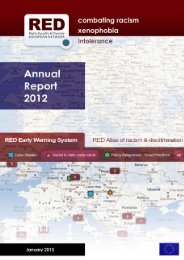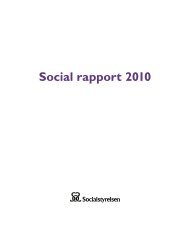Entry Testing and the Overrepresentation of Romani ... - UR Research
Entry Testing and the Overrepresentation of Romani ... - UR Research
Entry Testing and the Overrepresentation of Romani ... - UR Research
- No tags were found...
You also want an ePaper? Increase the reach of your titles
YUMPU automatically turns print PDFs into web optimized ePapers that Google loves.
R40PITFALLS AND BIASOrientation Test for School MaturityKern’s School Maturity Test was developed in German in 1970, with a Czech revision by Jirásek, also in 1970. It isone <strong>of</strong> <strong>the</strong> most widely used assessments <strong>of</strong> a child’s readiness for school in <strong>the</strong> Czech Republic. There are threecomponents to this test: (1) human figure drawing; (2) copying simple, short sentences; <strong>and</strong> (3) copying a group<strong>of</strong> dots/points. Nováková <strong>and</strong> Prokopec (2002) assert that, after three decades, this is still <strong>the</strong> best tool forassessing school readiness, <strong>and</strong> if a child is not successful in this test, <strong>the</strong> child should be referred for assessmentfor special educational needs. However, this test has not been revised since <strong>the</strong> 1970s <strong>and</strong> does not take intoconsideration <strong>the</strong> cultural backgrounds <strong>of</strong> <strong>Romani</strong> children, so <strong>the</strong> assertion that this is <strong>the</strong> best instrument forassessing school readiness is questionable. While this test might be reliable in assessing readiness for school for<strong>the</strong> ethnic Czech population, it is not reliable in assessing immaturity (Kovářová, 2008, quoting <strong>the</strong> administrationmanual). If a child performs below <strong>the</strong> st<strong>and</strong>ard, <strong>the</strong> test must be re-administered after three months, <strong>and</strong> only<strong>the</strong>n should a child be referred to a School Advisory Facility for fur<strong>the</strong>r psychological <strong>and</strong>/or educational testing(Trnková, 2009, 37). It is important that this three-month re-administration protocol be followed <strong>and</strong> that pupilswho perform below <strong>the</strong> st<strong>and</strong>ard be provided with opportunities to practice <strong>the</strong> skills assessed so that when<strong>the</strong>y are re-assessed <strong>the</strong>y have <strong>the</strong> opportunity to demonstrate <strong>the</strong>ir growth over time.CONSEQUENCES OF TEST RESULTSFOR SCHOOL AND LABOR MARKET OUTCOMESLevels <strong>of</strong> education heavily impact participation in <strong>the</strong> labor market, particularly for members <strong>of</strong> <strong>Romani</strong> communities.Students must take entrance examinations to be accepted to secondary schools (ISCED 3), <strong>and</strong> most <strong>of</strong> <strong>the</strong>schools are competitive. Like <strong>the</strong> unified system <strong>of</strong> primary schools, <strong>the</strong> 2004/5 amendments to <strong>the</strong> EducationAct placed all schools, including practical (special) secondary schools under <strong>the</strong> single umbrella <strong>of</strong> “secondaryschools.” However, in practice, <strong>the</strong> divisions among secondary schools remain. There are three tracks in secondaryschooling: (1) secondary education that can be completed in one to two years that prepares <strong>the</strong> student forlow-skilled labor (ISCED 3C); (2) secondary education that can be completed in two to three years where <strong>the</strong> studentattains an apprenticeship certificate (ISCED 3C); <strong>and</strong>, 3) secondary education that can be completed in a sixoreight-year gymnasium, or a four-year program where <strong>the</strong> student completes a school leaving examination (ISCED3A). This last track is <strong>the</strong> only form <strong>of</strong> secondary education where students have <strong>the</strong> option to go on to tertiaryeducation.The high rate <strong>of</strong> unemployment in <strong>Romani</strong> communities corresponds with low levels <strong>of</strong> educational attainment.In marginalized communities (settlements), only 39.1 percent <strong>of</strong> <strong>the</strong> working age population is employed (Bodewig<strong>and</strong> Rutkowski 2008, 9). Bodewig <strong>and</strong> Rutkowski (2008, 6) go on to make a distinction between “unemployed,”which means that individuals are actively seeking employment, <strong>and</strong> “not in <strong>the</strong> labor force,” which indicates thatindividuals have stopped seeking employment after actively searching <strong>and</strong> not finding employment. According




